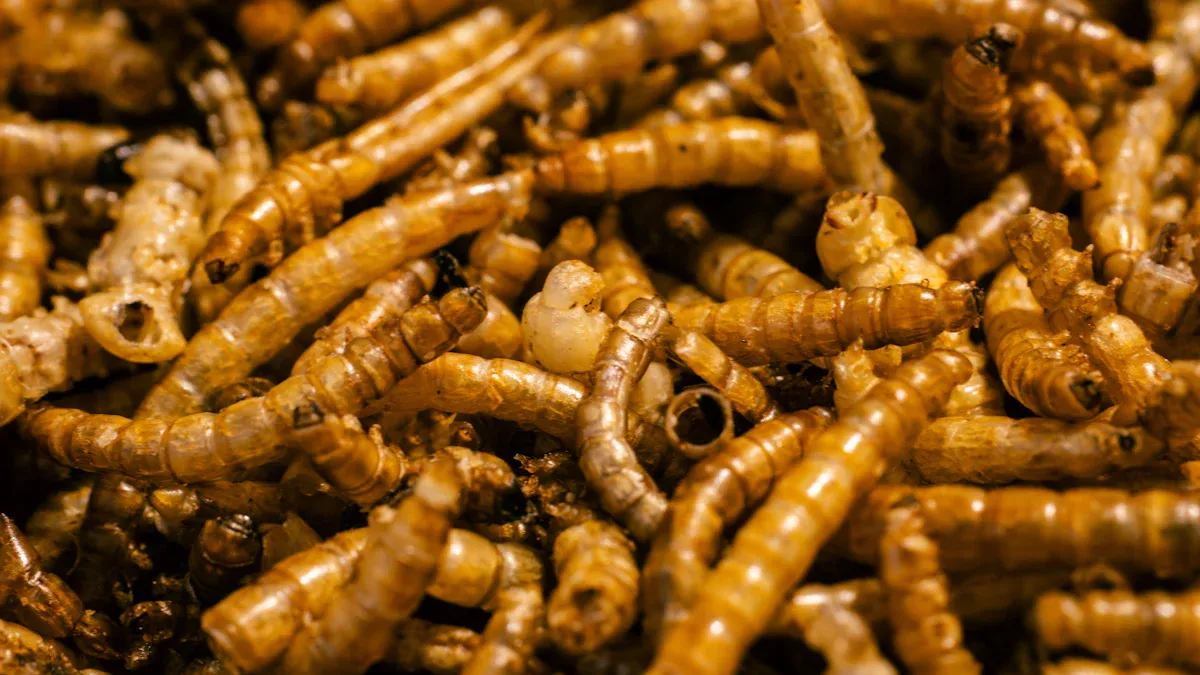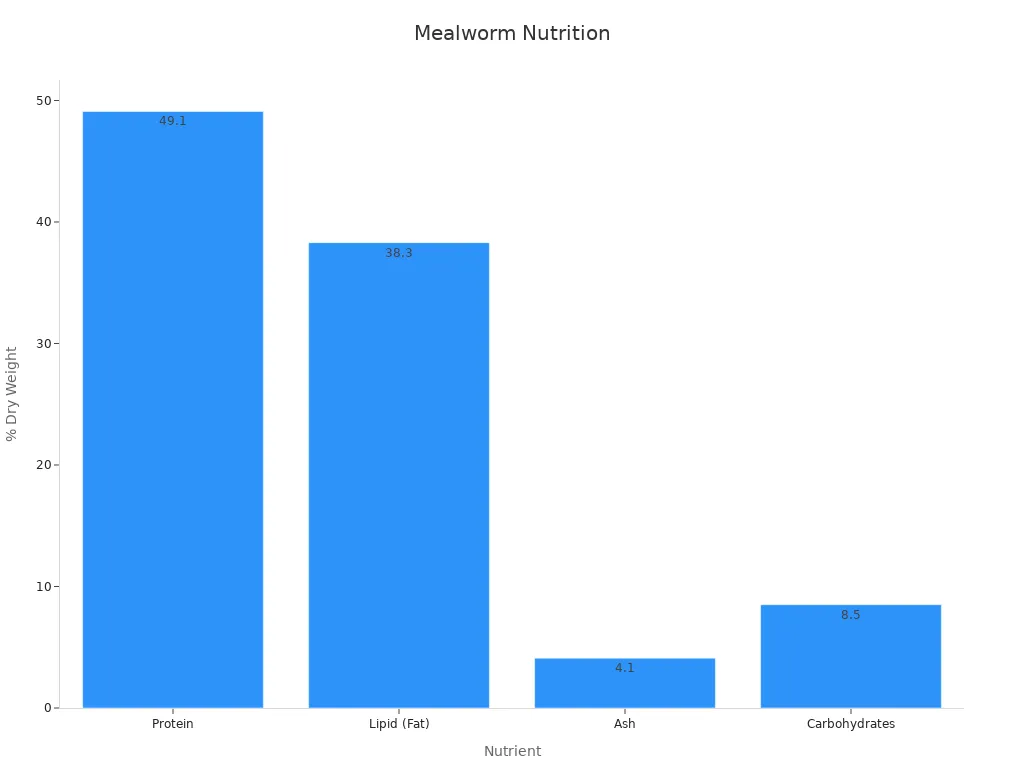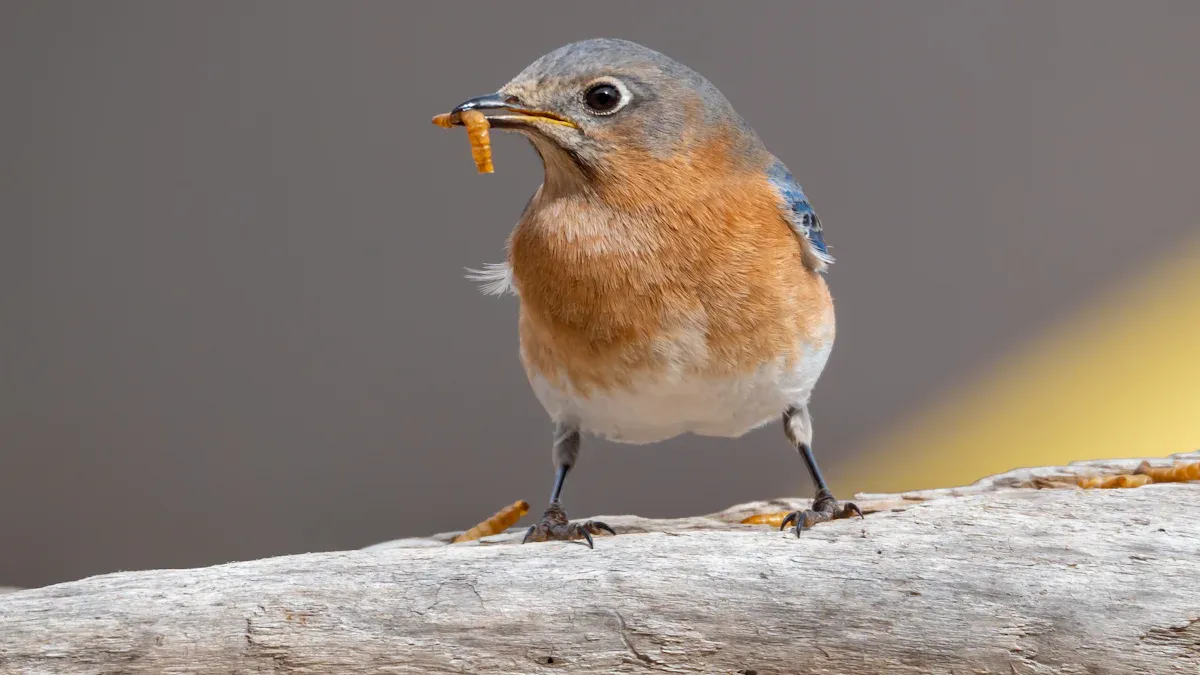
Not every pet will love or need freeze dried mealworms. Some animals enjoy them as a tasty treat, while others might not handle them well. Pet owners should always think about their pet’s unique needs. Freeze dried mealworms offer nutrition, but safety comes first.
Key Takeaways
- Freeze dried mealworms have lots of protein and good fats. They are a healthy snack for many pets like birds, reptiles, and small mammals.
- Give your pet a small amount of mealworms at first. Watch your pet for allergies or stomach problems to keep them safe and healthy.
- Some pets should not eat mealworms. Do not give them to rabbits or guinea pigs. Always ask a vet before you change your pet’s food.
Freeze Dried Mealworms: What They Are and Their Nutritional Value
How Freeze Dried Mealworms Are Made
Freeze dried mealworms start as live larvae. Producers fast the larvae for about 24 hours. This step helps clear their digestive systems. Next, they rinse the larvae with clean water. After rinsing, they freeze the mealworms at -18°C for four hours. The frozen larvae then go into a freeze-dryer at -85°C for 48 hours. This process removes moisture while keeping nutrients locked in. Once dry, the mealworms can be ground into powder or packaged whole. This method keeps the mealworms fresh and safe for pets. Analytical studies show that freeze drying preserves the protein, fat, and vitamins better than other drying methods.
| Step | Description | Conditions/Parameters |
|---|---|---|
| Fasting | Larvae fasted before processing | 24 hours |
| Rinsing | Clean water rinse | – |
| Freezing | Frozen in thin layers | -18°C for 4 hours |
| Freeze-drying | Moisture removed by freeze-drying | -85°C for 48 hours |
| Grinding | Ground into powder (optional) | Blender |
| Packaging & Storage | Packed and stored at room temperature | – |
Nutritional Benefits of Freeze Dried Mealworms
Freeze Dried Mealworms offer a rich source of protein and healthy fats. Scientific studies show that they contain about 49% protein and 38% fat by dry weight. They also provide fiber, ash, and carbohydrates. The feeding substrate for these mealworms includes wheat bran, carrots, oranges, and other plant materials, which help boost their nutrition. These mealworms also supply important micronutrients like zinc, which supports antioxidant health in pets. The freeze drying process keeps these nutrients stable and bioavailable.

Pet owners choose freeze dried mealworms because they are a convenient, nutritious treat for many animals. The product’s high protein and fat content make it a favorite for birds, reptiles, and small mammals.
Freeze Dried Mealworms for Different Types of Pets

Birds
Birds love to snack on insects. Freeze Dried Mealworms make a great treat for many pet birds, including finches, canaries, and parrots. These mealworms give birds a boost of protein and fat, which helps them stay active and healthy. Many bird owners notice brighter feathers and more singing when they add mealworms to their pets’ diets.
A study with broiler chickens showed that adding mealworm meal to their food helped them grow bigger and faster. The birds also used their food more efficiently. Here’s a quick look at the results:
| Parameter | Effect of Mealworm Meal Inclusion in Broiler Diets | Statistical Significance (p-value) |
|---|---|---|
| Final body weight | Increased from ~2858 g to ~3176 g | < 0.001 (linear increase) |
| Body weight gain | Increased from ~1855 g to ~2173 g | < 0.001 (linear increase) |
| Feed conversion ratio | Decreased from 1.82 to 1.55 | < 0.001 (linear decrease) |
Another study with Japanese quail found that dried mealworms improved growth and health. These results show that Freeze Dried Mealworms can help birds thrive.
Tip: Sprinkle a small amount of mealworms on top of your bird’s regular food to encourage foraging and natural behavior.
Reptiles and Amphibians
Reptiles and amphibians often eat insects in the wild. Freeze Dried Mealworms are a popular choice for pets like leopard geckos, bearded dragons, and frogs. These mealworms offer a good mix of protein and fat, which helps reptiles and amphibians grow and stay strong.
- Mealworms are a common feeder insect for reptiles and amphibians.
- Their nutrition can be improved by feeding them healthy foods before drying.
- Some reptiles and amphibians need extra vitamin A, so owners may need to add supplements.
- Clean and safe mealworms help prevent sickness in pets.
- Freeze Dried Mealworms have nutrients similar to wild insects.
Pet owners should always dust mealworms with calcium powder before feeding. This helps balance the minerals in their pets’ diets.
Small Mammals (Hamsters, Gerbils, Mice)
Small mammals like hamsters, gerbils, and mice enjoy a little animal protein in their diets. Freeze Dried Mealworms can be a tasty treat for these pets. The protein and fat in mealworms help small mammals build muscle and stay energetic.
Owners often use mealworms as a reward during training or playtime. Just a few mealworms at a time can make a big difference in their pets’ happiness. Always start with a small amount and watch for any changes in behavior or digestion.
Dogs and Cats
Some pet owners want to try new protein sources for their dogs and cats. Freeze Dried Mealworms offer a unique option. Dogs often find the smell of mealworms very appealing. In one study, dogs with skin problems improved after eating a mealworm-based diet. Their coats looked better, and they scratched less.
- Dogs liked the taste and smell of mealworms.
- Mealworm protein is easy for dogs to digest.
- Some dogs with food allergies did better on insect-based diets.
Cats can also eat insect protein. Studies show that cats digest insect meals well and usually have no trouble with their stomachs. Some cats may not like the taste at first, so owners should introduce mealworms slowly.
Note: Always check with a vet before making big changes to your dog’s or cat’s diet.
Fish and Exotic Pets
Fish, turtles, and other exotic pets often eat insects in the wild. Freeze Dried Mealworms can be a great treat for these animals. Many aquarium fish, such as bettas and cichlids, enjoy hunting and eating mealworms. Turtles and some lizards also benefit from the extra protein.
Owners should feed mealworms in small amounts to avoid overfeeding. Watch how your pet reacts and adjust the amount as needed.
Important Cautions and Exceptions
Not every pet can eat Freeze Dried Mealworms safely. Some animals have trouble digesting insects or may have allergies. Always start with a small amount and watch for any signs of stomach upset or allergic reaction.
Warning: Never feed mealworms to pets that should not eat animal protein, such as rabbits or guinea pigs.
Pet owners should always choose high-quality products. Look for mealworms that are clean, free from additives, and properly packaged. When in doubt, ask a veterinarian for advice.
How to Safely Add Freeze Dried Mealworms to Pet Diets
Choosing the Right Portion Size
Pet owners often wonder how much is too much. The right portion depends on the pet’s size, species, and age. Small birds or hamsters may only need a few mealworms at a time. Larger pets, like reptiles or chickens, can handle a small handful. Experts suggest starting with a small amount and watching how the pet reacts. Most pets do best when mealworms make up less than 10% of their total diet. This helps keep their meals balanced and prevents overfeeding.
Tips for Introducing Freeze Dried Mealworms
Introducing a new food can be fun for both pets and owners. Many pets enjoy the taste and texture of Freeze Dried Mealworms. Owners can mix a few mealworms into regular food or offer them by hand as a treat. Some pets may need time to get used to the new flavor. Try offering mealworms during playtime or training. Always use clean, high-quality products. Scientific studies show that proper processing—like blanching, freezing, and freeze-drying—keeps mealworms safe and nutritious. Farms use controlled breeding and hygienic methods to make sure the mealworms are healthy and clean.
- Start with a small amount.
- Mix with regular food.
- Watch for excitement or curiosity.
- Store mealworms in a cool, dry place.
Signs to Watch For and When to Avoid
Not every pet will react the same way. Owners should watch for changes in behavior, appetite, or digestion. Signs like vomiting, diarrhea, or itching mean it is time to stop feeding mealworms. Some pets, such as rabbits or guinea pigs, should never eat animal protein. If a pet has allergies or a sensitive stomach, owners should talk to a vet before trying new foods.
Tip: Always introduce new treats slowly and watch for any unusual signs.
Pet owners see many benefits when they add mealworms to pet diets. Scientific studies show:
- Mealworms offer high protein, vitamins, and minerals.
- Pets show better growth, energy, and natural behaviors.
- Mealworms store well and support eco-friendly feeding.
- Owners should always check their pet’s needs first.
Always talk to a veterinarian before changing a pet’s diet.
Article author: Felix
FAQ
Can puppies or kittens eat freeze dried mealworms?
Puppies and kittens should not eat freeze dried mealworms. Their digestive systems need time to mature. Always ask a vet before giving new treats to young pets.
How should pet owners store freeze dried mealworms?
Store freeze dried mealworms in a cool, dry place. Use an airtight container. This keeps them fresh and safe for pets.
Tip: Keep the package sealed after each use to prevent moisture.
Are freeze dried mealworms safe for pets with allergies?
Some pets have allergies to insect protein. Owners should introduce mealworms slowly. Watch for itching or stomach upset. If problems appear, stop feeding and contact a veterinarian.


